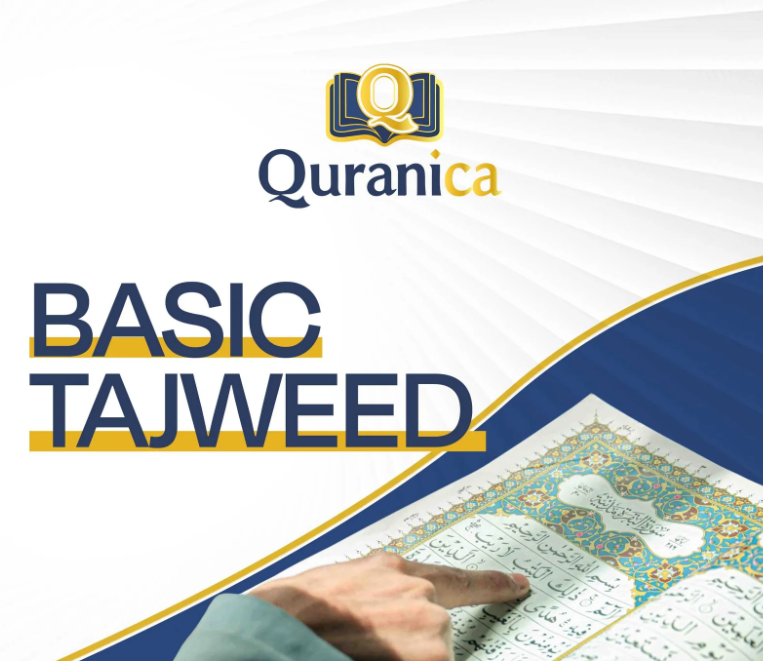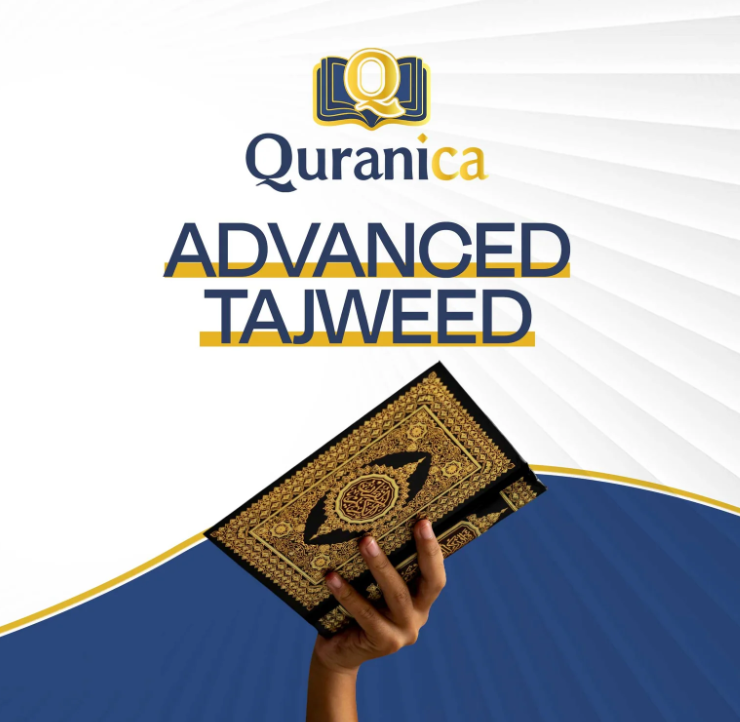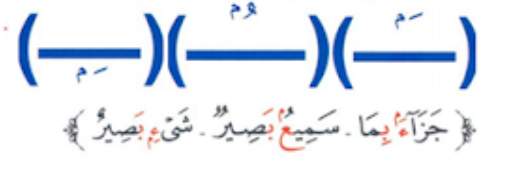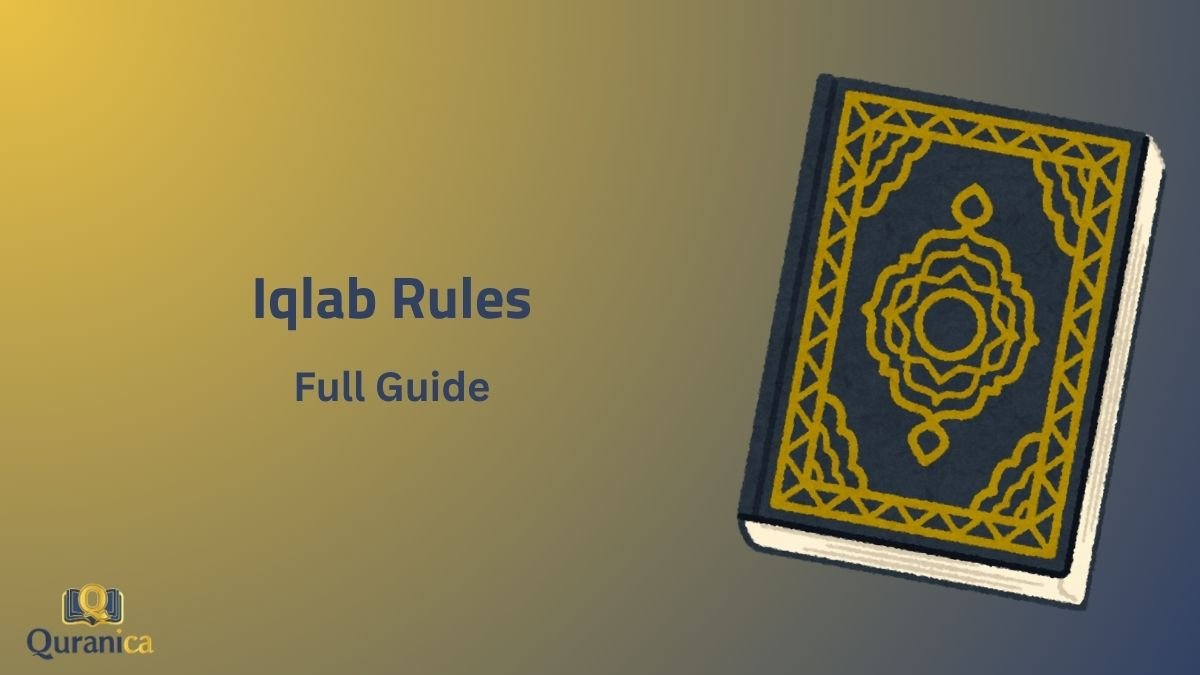In a nutshell: Iqlab is a Tajweed rule that requires changing a Noon Sakinah or Tanween into a Meem sound with nasalization (Ghunnah) when followed by the letter Bā’ (ب). This subtle shift, marked by a tiny Meem symbol in the Quran, plays a key role in refining recitation. Unlike other rules like Idhar, Idgham, or Ikhfaa, Iqlab fully transforms the sound.
We will explore one of the most interesting rules of Tajweed, known as Iqlab. Understanding this rule is a key step in beautifying your recitation and reading the Holy Quran exactly as it was revealed.
Iqlab is one of the four essential rules that apply to a Noon As-Sakinah (a Noon with no vowel) and Tanween.
Iqlab is a simple yet vital concept that, once mastered, will make your recitation more accurate. Let’s learn it together, step by step.
The Definition of Iqlab
To truly grasp the rule of Iqlab, we first need to understand what the word itself means, both in the Arabic language and in the science of Tajweed. This helps us appreciate the precision of Quranic sciences.
1. The Linguistic Definition of Iqlab in Arabic
In the Arabic language, the word “Iqlab” (إِقْلَاب) literally means “to turn over,” “to convert,” or “to flip something from one state to another.” This linguistic meaning perfectly describes the action that happens when we apply this rule.
2. What is Iqlab in Tajweed?
In Tajweed, Iqlab is the rule that instructs us to convert the sound of a Noon Sakinah (نْ) or a Tanween (ـًـــٍـــٌ) into a light Meem (م) sound.
This conversion only happens when it is immediately followed by the letter Bā’ (ب).
This new Meem sound is then held with a gentle nasalization, known as Ghunnah.
Iqlab and Ghunnah
Pronouncing Iqlab correctly involves two simple but very important actions. Practicing this will make your recitation sound natural and beautiful.
1. Conversion
The first step is to change the sound. As you approach the Noon or Tanween, instead of preparing to make an ‘n’ sound, you gently close your lips to articulate a Meem (م) sound. Your lips should touch lightly, without pressing them firmly together.
2. Ghunnah (Nasalization)
The second step is to hold this new Meem sound for a duration of two counts.
While holding it, you should feel a gentle vibration or resonance in your nasal passage. This beautiful nasal sound is the Ghunnah.
The Rule of Iqlab
Now that we know what Iqlab means, let’s look at how it actually works during recitation. The rule of Iqlab is wonderfully simple because it applies in only one specific situation, making it easy to remember.
What Are The Letters of Iqlab
The rule of Iqlab has only one letter that triggers it: the letter Bā’ (ب).
This means that whenever you are reciting the Quran and you see a Noon Sakinah or a Tanween followed immediately by a Bā’ (ب), you must apply the rule of Iqlab. No other letter causes this change.
Iqlab with Noon Sakinah
Let’s focus more closely on how Iqlab works with a Noon Sakinah (نْ). This is the original form of the rule, and understanding it well makes it easier to understand how it applies to Tanween.
The rule applies to Noon Sakinah whether it appears in the middle of a word or between two separate words. The key is that the Noon must be sakin (have no vowel) and be followed immediately by the letter Bā’ (ب).
Noon Saakin Iqlab Examples from Quran
Here are more clear examples to help you see how the Noon Sakinah is converted. Listen for the ‘m’ sound where you would expect an ‘n’ sound.
1. Examples of Noon Saakin Iqlab In the middle of a word
“يُنۢبِتُ لَكُم بِهِ ٱلزَّرْعَ وَٱلزَّيْتُونَ”
Yumbitu lakum bihi az-zar’a waz-zaytoon
“He causes to grow for you thereby the crops and olives…”
Notice in يُنۢبِتُ (yunbitu), the Noon is converted into a Meem and pronounced as Yum-bitu, with a light Ghunnah on the Meem sound.
“قَالَ يَـٰٓـَٔادَمُ أَنۢبِئْهُم بِأَسْمَآئِهِمْ”
Qāla yā ‘ādamu ambi’hum bi’asmā’ihim
“He said, ‘O Adam, inform them of their names.'”
In this verse, the word is أَنْبِئْهُمْ (anbi’hum), but with Iqlab, we pronounce it as am-bi’hum, changing the ‘n’ sound to an ‘m’ sound.
2. Examples of Noon Saakin Iqlab Between two words
“نُّسْقِيكُم مِّمَّا فِى بُطُونِهِۦ مِنۢ بَيْنِ فَرْثٍ وَدَمٍ”
Nusqeekum mimmā fī buṭūnihi mim bayni farthin wa dam
“We give you drink from what is in their bellies – between excretion and blood…”
The phrase مِنْ بَيْنِ (min bayni) is read as mim bayni. The Noon at the end of the first word is flipped into a Meem because the next word begins with Bā’.
“ٱلَّذِينَ يَنقُضُونَ عَهْدَ ٱللَّهِ مِنۢ بَعْدِ مِيثَٰقِهِ”
Alladheena yanqudoona ‘ahda Allahi mim ba’di meethāqih
“Who break the covenant of Allah after contracting it…”
Here, مِن بَعْدِ (min ba’di) is pronounced as mim ba’di. The Noon is flipped into a Meem.
Mastering rules like this is a key focus in Quranica’s Learn Tajweed for beginners Course, where our expert teachers guide you through each step.

Iqlab with Tanween
Now let’s explore Iqlab with Tanween. Tanween is the doubling of the short vowels at the end of a word, which creates a sound identical to a Noon Sakinah. For this reason, it follows the exact same rules.
This rule applies to all three types of Tanween when they are followed by the letter Bā’ (ب). The ‘n’ sound of the Tanween is converted into a Meem sound with Ghunnah.
Iqlab Tanween Examples from Quran
Seeing examples for each type of Tanween will make the concept perfectly clear. You will notice that the small superscript Meem (م) is also used here to mark the rule.
1. Iqlab Tanween Damma Example
“إِنَّهُۥ عَلِيمٌۢ بِذَاتِ ٱلصُّدُورِ”
Innahu ‘aleemum bidhāti aṣ-ṣudūr
“Indeed, He is Knowing of that within the breasts.”
Here, عَلِيمٌ بِذَاتِ (‘aleemun bidhati) is pronounced ‘aleemum bidhati. The ‘un’ sound becomes an ‘um’ sound.
2. Iqlab Tanween Fatha Example
“جَزَآءًۢ بِمَا كَسَبَا نَكَٰلًا مِّنَ ٱللَّهِ”
Jazā’am bimā kasabā nakālam mina Allāh
“…in recompense for what they committed as a deterrent [punishment] from Allah”
In this verse, جَزَآءً بِمَا (jazā’an bimā) is articulated as jazā’am bimā, with the ‘an’ sound turning into an ‘am’ sound.
3. Iqlab Tanween Kasra Example
“بِأَيْدِى سَفَرَةٍۢ كِرَامٍۭ بَرَرَةٍۢ”
Bi’aydī safarah, kirāmim bararah
“[Carried] by the hands of messenger-angels, noble and dutiful.”
The phrase كِرَامٍ بَرَرَةٍ (kirāmin bararah) is recited as kirāmim bararah. The ‘in’ sound of the Tanween is converted to an ‘im’ sound before the letter Bā’.
Perfecting the timing and quality of Ghunnah is a delicate skill. In Quranica’s Advanced Tajweed Course, students work one-on-one with tutors to perfect these finer points of pronunciation until they become second nature.

The Iqlab Symbol in the Quran
When you read a modern copy of the Mushaf (the written Quran), you will find a tiny, superscript Meem (م) placed directly above the Noon Sakinah.

For Tanween, this small Meem replaces the second vowel marking.

This little Meem is not part of the original word; it is a visual aid added by scholars to remind the reciter to apply the rule of Iqlab. When you see it, you know you need to convert the Noon sound to a Meem.
Read also: Is Tajweed Obligatory In Salah?
Difference between Iqlab and Other Rules of Noon Saakin
To become truly confident in your recitation, it is helpful to see how Iqlab compares to the other rules of Noon Sakinah and Tanween.
Each rule has a unique sound and is triggered by a different set of letters, making your recitation rich and precise.
1. Iqlab vs. Idhar (The Clarity)
Idhar (الإِظْهَار) means “to make clear.” In this rule, the Noon Sakinah or Tanween is pronounced fully and clearly, with no change and no Ghunnah. This happens when the Noon is followed by one of the six throat letters (ء, هـ, ع, ح, غ, خ).
The key difference is that Idhar keeps the Noon sound exactly as it is, while Iqlab completely changes the Noon sound into a Meem sound.
2. Iqlab vs. Idgham (The Merging)
Idgham (الإِدْغَام) means “to merge.” Here, the Noon Sakinah or Tanween is merged into the following letter, so the Noon sound disappears and the next letter is stressed. This applies to the letters in the word يَرْمَلُون (yarmaloon).
In Iqlab, the Noon is converted into a Meem before the letter Bā’. In Idgham, the Noon is merged into one of the six Idgham letters.
The Noon sound is absent in Idgham, but in Iqlab, it is replaced by a clear Meem sound.
3. Iqlab vs. Ikhfaa (The Hiding)
Ikhfaa (الإِخْفَاء), which means “to hide,” is the most common rule. It applies to the 15 letters not covered by Idhar, Idgham, or Iqlab.
Here, the Noon sound is partially hidden, pronounced with a light Ghunnah while the mouth prepares for the next letter.
Iqlab is different because it requires a full conversion to a Meem sound by closing the lips.
In Ikhfaa, the lips do not close to make a Meem; instead, the sound is veiled in the nasal passage.
Distinguishing between these rules comes with practice, and you can sharpen your skills with Quranica’s Tajweed test and practice sessions.

Common Mistakes When Pronouncing Iqlab
Being aware of these small mistakes is the first step toward avoiding them and perfecting your recitation, insha’Allah.
1. Leaving a Gap Between the Lips
Some learners, in an effort to avoid pressing the lips too hard, go to the other extreme and leave a small gap between them.
This is also incorrect as it prevents the proper articulation of the Meem (م) sound.
To correctly pronounce Iqlab, the lips must make contact.
The conversion from Noon to Meem requires the lips to close, even if it is a very light closure. This produces the correct sound to be held with Ghunnah.
2. Cutting the Ghunnah Short
In the flow of recitation, it can be easy to rush the Ghunnah of Iqlab. Many students hold the Meem sound for less than a moment before moving to the letter Bā’ (ب), which makes the rule incomplete.
The Ghunnah is a core part of the Iqlab rule.
Be sure to give it its proper right by holding the nasalized Meem sound for a clear two counts. This gives the recitation its proper rhythm and beauty.
3. Incomplete Conversion of the Noon
Sometimes, a faint trace of the original Noon (ن) sound can be heard just before the Meem is pronounced.
This happens when the “flip” from one sound to the other is not immediate or complete.
The rule of Iqlab demands a total conversion. The Noon sound should vanish completely, replaced instantly by the Meem sound the moment your lips touch.
Read also: Tajweed Symbols And Stop Signs
Master Iqlab and More with Quranica
Mastering Tajweed is a journey of devotion, a sincere effort to connect with the words of Allah. At Quranica, we are here to walk with you on every step of that blessed journey.
Here at Quranica, we are blessed with a dedicated team whose passion is to help non-Arabs like you connect with the Quran.
- Authentic Teachers: Many of our instructors are native Arab speakers, graduates of esteemed institutions like Al-Azhar University, bringing genuine expertise and passion.
- Qualified & Experienced: We have teachers holding Ijazah (certification to teach Quran recitation) and possess extensive experience specifically in teaching Quran and Arabic to non-Arabs. We understand the challenges and joys of your learning journey.
- Personalized Learning: We strive to tailor the experience to your needs and pace.
- Value: We aim to provide high-quality education with competitive pricing.
Whether you are just beginning or seeking to deepen your existing knowledge, we have courses designed for you:
- Online Quran Classes for Beginners: Start your journey with the basics.
- Learn Quran with Tajweed: Beautify your recitation according to the rules.
- Quran Memorization and Hifz: Embark on the blessed path of memorizing Allah’s words.
- Online Quran Tafseer Course: Dive deeper into the meaning and interpretation of the Quran.
- Learn Arabic Online Course: Unlock the beauty of the Quran’s original language.
- Quranic Arabic to deepen your understanding to the specific language styles in Quran.
Explore our full range of courses.
Enroll in a Quranica course now!
Conclusion
Iqlab is one of the four core Tajweed rules applied to Noon Sakinah and Tanween, involving the conversion of the ‘n’ sound to a Meem (م) when followed by the letter Bā’ (ب). This transformation enhances fluency and beauty in Quranic recitation.
The process involves two main steps: switching the Noon or Tanween into a Meem sound, followed by holding that sound with nasalization (Ghunnah) for two counts. This pronunciation is subtle yet essential.
Iqlab differs from Idhar (clear pronunciation), Idgham (merging), and Ikhfaa (hiding) in its complete transformation of sound. Each rule has distinct conditions and effects on recitation.
Common mistakes include incomplete lip closure, shortened Ghunnah, or unclear transitions.








0 Comments